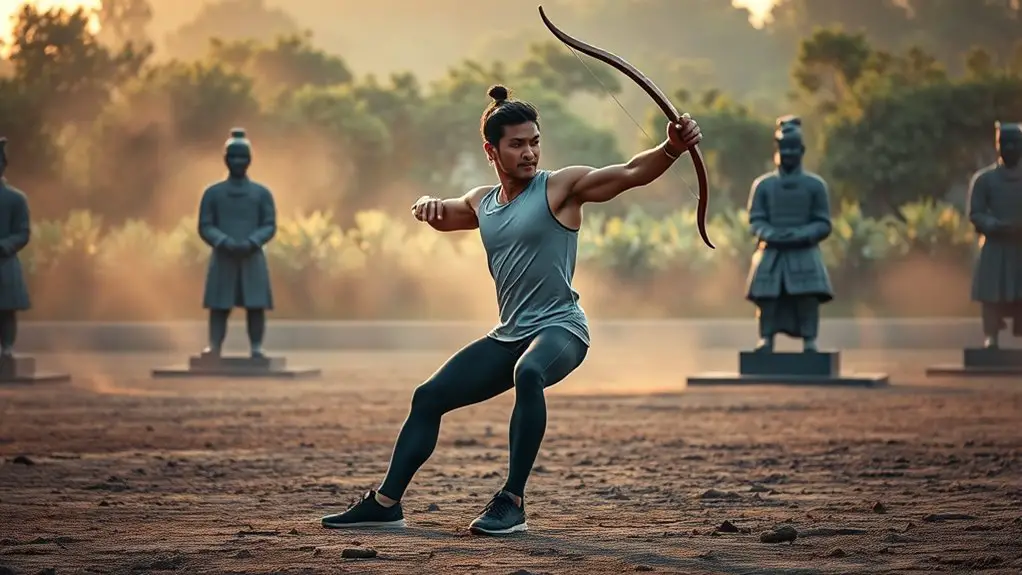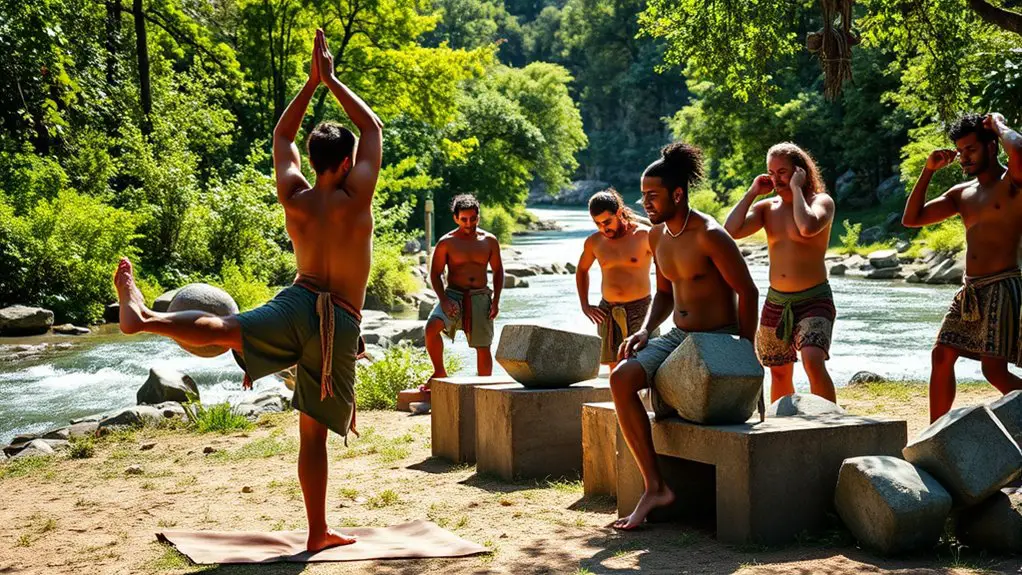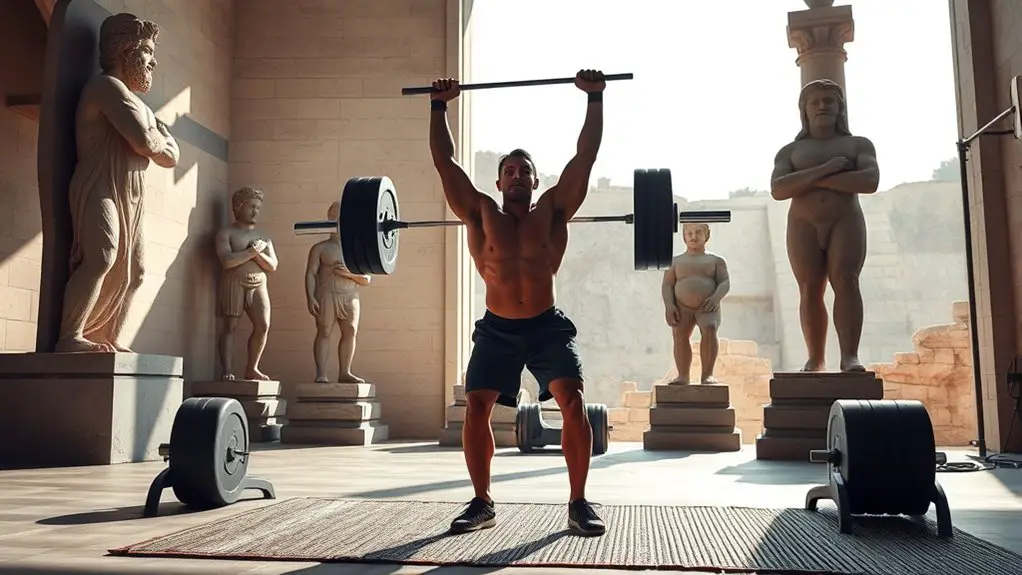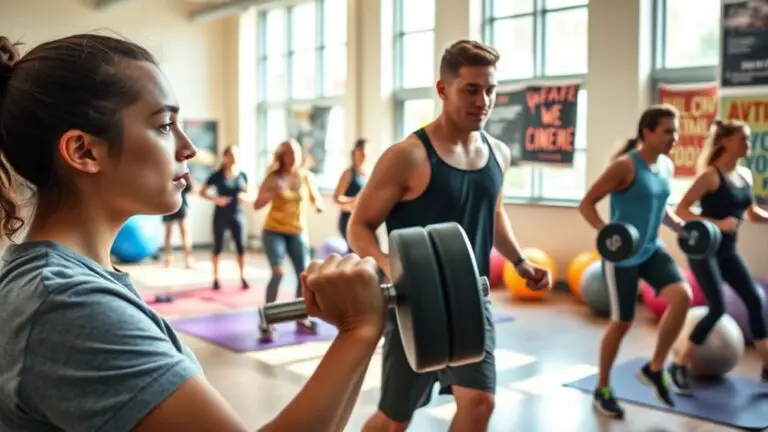How Ancient Training Techniques Can Help Modern Athletes

Ancient training techniques offer modern athletes valuable strategies to enhance their performance. By incorporating practices like breath control and meditation, you can boost focus and mental resilience. Additionally, lessons from traditional cultures emphasize functional movement and community support. Nutritional principles from ancient times also promote sustained energy and recovery. By integrating these ancient insights into your routine, you can achieve greater strength and well-being, making it worthwhile to explore how they can elevate your training further.
The Legacy of Greek Olympians: Strength and Discipline

Although modern training methods have evolved, the legacy of Greek Olympians continues to influence athletic practices today, underscoring the importance of strength and discipline. Greek strength was characterized by rigorous physical training, often incorporating bodyweight exercises and competitive events that fostered resilience. You can observe how these foundational techniques have been integrated into contemporary athletic regimens, emphasizing functional strength and endurance.
Olympic discipline, a hallmark of ancient Greek training, remains relevant as it cultivates mental fortitude alongside physical prowess. Athletes today often adopt similar training principles, focusing on consistency, goal-setting, and self-regulation. Research supports that a disciplined approach leads to higher performance outcomes. By embracing these ancient techniques, you can enhance your athletic capabilities, harnessing the wisdom of the past while adapting to modern demands. Understanding this legacy not only enriches your training but also connects you with a historical continuum of athletic excellence.
Mind-Body Connection in Eastern Martial Arts
In Eastern martial arts, the mind-body connection is essential for ideal performance and mental clarity. Techniques such as breath control, meditation, and energy flow awareness enhance focus and physical execution. By incorporating these practices, you can improve both your mental resilience and athletic capabilities.
Breath Control Techniques
Breath control techniques play a crucial role in enhancing the mind-body connection within Eastern martial arts, as practitioners harness their breath to influence both physical performance and mental clarity. One effective method is diaphragmatic breathing, which involves engaging the diaphragm to improve lung capacity and oxygen intake. This technique promotes a deeper, more rhythmic inhalation, allowing you to maintain focus and reduce stress during training. Research suggests that controlled breathing can lower heart rates and enhance overall athletic performance. By integrating these techniques into your practice, you can cultivate greater awareness of your body and its movements, ultimately leading to improved coordination and concentration. Embracing breath control isn’t just about physical ability; it’s also a powerful tool for mental resilience.
Meditation and Focus
While many athletes focus solely on physical training, the integration of meditation into their routines can greatly enhance mental focus and performance. Research shows that practices like mindful breathing can improve concentration and reduce anxiety, leading to better outcomes during competition. By cultivating focused awareness through meditation, you can develop a clearer mindset, allowing you to respond more effectively under pressure. Studies indicate that athletes who incorporate meditation experience increased resilience and improved decision-making abilities. Additionally, this practice can help you maintain a calm demeanor, which is essential in high-stakes situations. Ultimately, blending meditation with your physical training can create a holistic approach, maximizing both mental acuity and physical prowess in your athletic endeavors.
Energy Flow Awareness
Many athletes may overlook the significance of energy flow awareness, a concept deeply rooted in Eastern martial arts that emphasizes the mind-body connection. Understanding how energy pathways, or meridians, facilitate chi flow can enhance your performance. Research indicates that when you cultivate awareness of these pathways through techniques like Tai Chi or Qigong, you may improve coordination, balance, and overall athletic efficiency. By focusing on your breath and visualizing energy moving through your body, you’ll create a harmonious balance between mental focus and physical execution. This integration can lead to greater resilience against fatigue and injury. Ultimately, fostering energy flow awareness not only enhances athletic performance but also promotes holistic well-being, aligning both mind and body for ideal results.
The Role of Meditation in Athletic Performance
Meditation can greatly enhance your mental focus, an essential component for peak athletic performance. Research supports its effectiveness in reducing stress, allowing you to maintain composure under pressure. Additionally, visualization practices rooted in meditation can improve your ability to mentally rehearse and execute skills, ultimately leading to better outcomes in competition.
Mental Focus Enhancement
Achieving peak performance often hinges on an athlete’s ability to maintain mental focus, and recent studies suggest that incorporating meditation into training regimens can greatly enhance this aspect. By practicing meditation regularly, you can cultivate mental clarity and improve your focus techniques. Here are four benefits:
- Increased Concentration: Meditation trains your mind to stay present, sharpening your attention during competitions.
- Enhanced Decision-Making: A clear mind allows for quicker, more effective choices under pressure.
- Improved Resilience: Regular practice fosters mental strength, helping you bounce back from setbacks.
- Heightened Awareness: Meditation enables you to tune into your body’s signals, optimizing performance.
Integrating these practices can transform your athletic capabilities, allowing you to achieve your highest potential.
Stress Reduction Techniques
While competitive sports can often lead to heightened stress levels, incorporating meditation into your training routine can serve as an effective tool for managing this pressure. Mindfulness practices, rooted in ancient rituals, have been shown to reduce anxiety and enhance focus. Research indicates that athletes who engage in meditation experience lower cortisol levels, suggesting improved stress management. By regularly practicing meditation, you can cultivate a greater sense of awareness, allowing you to better handle the challenges of competition. Additionally, these techniques can improve recovery times, as reduced stress positively impacts physical health. Integrating these ancient mindfulness practices into your training can not only enhance your mental resilience but also elevate your overall athletic performance.
Visualization Practices
As athletes seek to enhance their performance, incorporating visualization practices can play an essential role in achieving their goals. Mental imagery helps you mentally rehearse scenarios, leading to improved outcomes. Here are four key benefits of visualization for performance enhancement:
- Increased Confidence: Visualizing success can boost your self-belief during competitions.
- Improved Focus: It sharpens your concentration, reducing distractions.
- Enhanced Skills: Regular mental practice can refine your techniques, making execution more fluid.
- Stress Management: Visualization can help you manage pre-competition anxiety, allowing for a calmer mindset.
Research shows that athletes who engage in these practices often outperform those who don’t. By integrating mental imagery into your training routine, you’re not just preparing physically but also mentally for the challenges ahead.
Ancient Nutrition Practices for Modern Athletes
Although modern sports nutrition often emphasizes convenience and supplementation, ancient cultures provide valuable insights into dietary practices that supported athletic performance. For instance, the consumption of ancient grains like quinoa and farro offered athletes essential nutrients and sustained energy levels. Additionally, herbal supplements such as ginseng and turmeric were used for their anti-inflammatory properties and to boost stamina.
| Ancient Nutrition Practices | Benefits |
|---|---|
| Ancient Grains | High in fiber and protein |
| Herbal Supplements | Anti-inflammatory effects |
| Balanced Meals | Sustained energy release |
Functional Movement: Lessons From Traditional Cultures

Understanding functional movement through the lens of traditional cultures reveals the importance of purposeful body mechanics in athletic performance. These cultural movements are not just historical artifacts; they offer practical lessons for enhancing modern athleticism. By examining traditional practices, you can discover valuable insights that can transform your training regimen.
- Holistic Approach: Traditional techniques encompass the entire body, promoting balance and coordination.
- Natural Movements: Many cultures emphasize movements that mimic daily activities, enhancing functionality.
- Adaptation to Environment: Athletes learned to adapt their techniques based on their surroundings, fostering resilience.
- Community and Support: Engaging in cultural practices often means being part of a community, which can motivate and inspire you.
Incorporating these lessons can help you develop a more effective and grounded approach to functional movement, leading to improved performance and reduced injury risk.
Breath Control Techniques for Enhanced Endurance
Breath control techniques can greatly enhance endurance, providing athletes with an essential edge in performance. By mastering breath patterns, you can improve oxygen delivery and energy efficiency. Diaphragmatic breathing, in particular, encourages deeper lung expansion, which maximizes oxygen intake.
| Technique | Benefits |
|---|---|
| Diaphragmatic Breathing | Increases lung capacity, reduces fatigue |
| Controlled Exhalation | Regulates heart rate, enhances focus |
| Rhythmical Breathing | Synchronizes breath with movement, improves stamina |
| Breath Counting | Promotes mindfulness, reduces anxiety |
Incorporating these techniques into your training routine can lead to more sustained energy levels during intense workouts. Studies indicate that athletes who utilize breath control experience less fatigue and maintain better performance over time. By focusing on your breath, you’re not just training your body, but also sharpening your mental resilience.
The Importance of Rest and Recovery in Ancient Regimens

While many modern athletes focus primarily on training intensity and volume, the ancient regimens emphasize the critical role of rest and recovery. Ancient recovery practices provided a framework for holistic healing, ensuring athletes could sustain their performance over time. Understanding the importance of rest can transform your training approach.
Consider these key aspects of ancient recovery:
- Rest Days: Scheduled downtime allowed the body to repair and rejuvenate muscles.
- Sleep Quality: Emphasizing restorative sleep improved overall health and athletic performance.
- Mindfulness: Practices like meditation reduced stress and enhanced focus, contributing to recovery.
- Nutrition: Proper nourishment during recovery periods supported healing and energy replenishment.
Incorporating these elements into your routine can lead to improved performance, prevent injuries, and promote long-term well-being. Ancient wisdom can guide you toward a more balanced and effective athletic journey.
Visualization Techniques Used by Ancient Warriors
Visualization techniques were integral to the training of ancient warriors, serving as a powerful mental tool to enhance performance on the battlefield. These warriors often employed strategic imagery to mentally rehearse combat scenarios, allowing them to anticipate and react to potential threats. By visualizing themselves in various situations, they developed a resilient warrior mindset that bolstered their confidence and focus.
Research indicates that mental imagery can considerably improve physical performance by reinforcing neural pathways associated with specific movements. Ancient warriors likely understood this concept intuitively, using visualization not just for combat readiness but also for instilling discipline and mental fortitude.
Moreover, the practice of visualizing triumphs over adversaries could mitigate anxiety and enhance emotional regulation. By integrating these ancient techniques, you can cultivate a similar warrior mindset, utilizing strategic imagery to optimize your performance in modern athletic endeavors. This historical insight can provide valuable tools for today’s competitive athletes.
Integrating Ancient Wisdom Into Contemporary Training Programs

As modern athletes seek to enhance their performance, integrating ancient training techniques can offer valuable insights into optimizing both physical and mental aspects of their regimen. By embracing ancient philosophies and cultural adaptations, you can enrich your training approach. Consider these methods:
- Holistic Conditioning: Ancient warriors trained their bodies and minds together, fostering balance and resilience.
- Breath Control: Techniques like pranayama from yoga can enhance your lung capacity and mental focus.
- Nature Immersion: Ancient cultures often trained outdoors, promoting physical conditioning and mental well-being.
- Goal Visualization: Inspired by ancient rituals, visualizing success can improve motivation and performance.
Frequently Asked Questions
What Are the Best Ancient Exercises for Building Overall Strength?
When considering the best ancient exercises for building overall strength, stone lifting and bodyweight exercises stand out. Stone lifting, practiced by various cultures, builds raw power and engages multiple muscle groups. Bodyweight exercises like push-ups and squats mimic traditional training methods, emphasizing functional strength and endurance. Both techniques rely on natural movements, promoting muscle development without the need for modern equipment. Integrating these practices can enhance your strength training regimen effectively.
How Did Ancient Athletes Recover From Injuries?
Did you know that nearly 70% of athletes in ancient Greece relied on natural remedies for recovery? They used ancient remedies like herbal poultices and oils to soothe inflammation and promote healing. Healing practices often included rest, massage, and hydrotherapy, emphasizing the importance of a holistic approach. By studying these methods, you can gain insights into effective recovery strategies that prioritize both physical and mental well-being, ensuring a balanced return to peak performance.
What Ancient Tools Can Be Used for Modern Training?
When considering ancient tools for modern training, stone weights and wooden clubs stand out. Stone weights, used by early athletes, provide a natural way to build strength and endurance. They challenge your muscles differently than modern equipment. Similarly, wooden clubs enhance grip and coordination while promoting dynamic movement patterns. Incorporating these tools can diversify your training regimen, offering a unique approach grounded in historical practice that may yield distinct benefits for your performance.
Did Ancient Cultures Prioritize Flexibility in Their Training Regimens?
Yes, ancient cultures did prioritize flexibility in their training regimens, recognizing its benefits. For instance, ancient Greeks incorporated stretching into their routines, believing that it enhanced performance and reduced injury risk. Similarly, Eastern philosophies, such as yoga from India, emphasized flexibility for both physical and mental well-being. These ancient practices underline the importance of flexibility, suggesting that integrating these philosophies can lead to improved athletic performance and overall health today.
How Can Ancient Techniques Be Adapted for Team Sports Today?
You can adapt ancient techniques for team sports by focusing on enhancing team dynamics and integrating tactical strategies. Historical training emphasized collaboration and communication, which are essential for modern teams. Incorporating drills that promote synergy can help players understand their roles better. Additionally, using ancient methods of conditioning can improve stamina and teamwork under pressure, allowing you to develop more effective on-field strategies that rely on collective effort, just as ancient warriors did.





